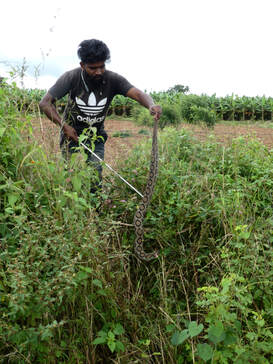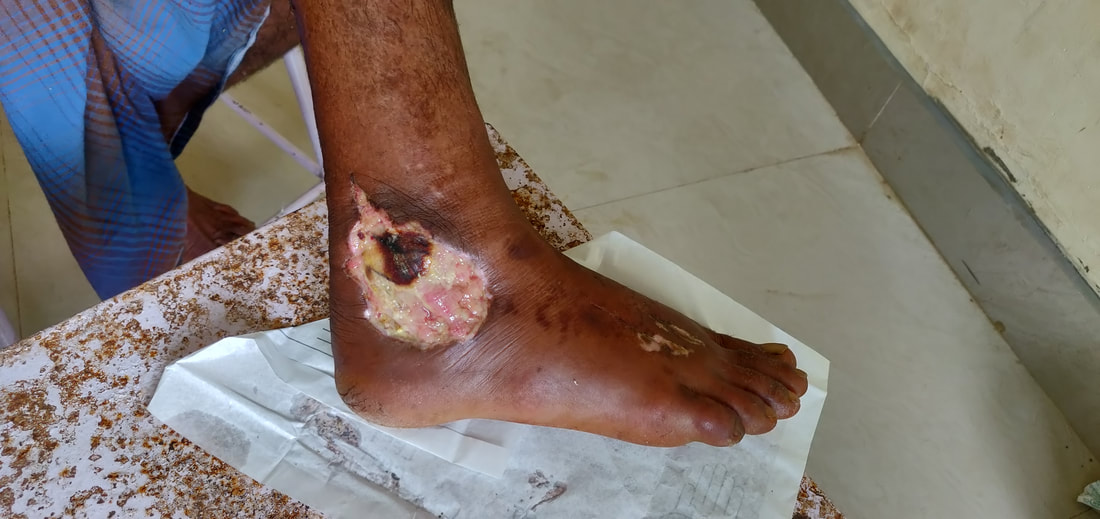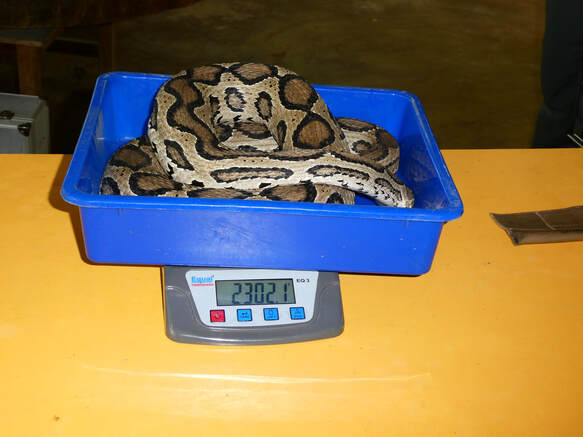TGMP: Russell's Viper Telemetry Project

HCI is sponsoring The Gerry Martin Projects Russell's Vipers Telemetry Projcect. The following is The Gerry Martin Projects summary of this study.
The Russell’s viper (Daboia russelii) is quite probably involved in more human-snake conflict than any other species in India. Further, it also accounts for more human-wildlife conflict than any other animal on the subcontinent! Unfortunately, this has been overlooked and even ignored by scientists, conservationists, and governments until recently.
With the permission and assistance of the Karnataka Forest Department, TGMP initiated the first-ever statistically sound ecology study of snakes in India. TGMP chose Russell’s viper as the study subject primarily because of the high level of conflict between humans and this species as well as the general public’s loathing and fear of this snake.
Russell’s vipers were captured from conflict situations, surgically implanted with radio transmitters and released back at the exact location of capture with the informed consent of relevant land or farm owners. These snakes have since been followed and studied every day to learn about their movements, natural history, behavior and habitat, and microhabitat preferences.
Alongside, we have also been documenting instances of conflict with the aim of clearly identifying high-risk seasons, practices and landscapes.
The Russell’s viper (Daboia russelii) is quite probably involved in more human-snake conflict than any other species in India. Further, it also accounts for more human-wildlife conflict than any other animal on the subcontinent! Unfortunately, this has been overlooked and even ignored by scientists, conservationists, and governments until recently.
With the permission and assistance of the Karnataka Forest Department, TGMP initiated the first-ever statistically sound ecology study of snakes in India. TGMP chose Russell’s viper as the study subject primarily because of the high level of conflict between humans and this species as well as the general public’s loathing and fear of this snake.
Russell’s vipers were captured from conflict situations, surgically implanted with radio transmitters and released back at the exact location of capture with the informed consent of relevant land or farm owners. These snakes have since been followed and studied every day to learn about their movements, natural history, behavior and habitat, and microhabitat preferences.
Alongside, we have also been documenting instances of conflict with the aim of clearly identifying high-risk seasons, practices and landscapes.
|
Why Russell’s Vipers?
The Russell’s viper is found through most of mainland India, from sea level to above 2000mASL in the Western Ghats and Himalayas. It is believed that the species is responsible for between 15,000 and 20,000 deaths in India each year. Due to the highly cytotoxic nature of its venom, survivors of bites from Russell’s vipers often suffer extensive and irreversible tissue damage. To make matters worse, poor first-aid and medical help in rural areas usually result in terrible infections, necrosis and gangrene that can only be resolved by amputations. Consequently, unlike the other common species of snakes, the long lasting visual reminder of bites from this species has led to numerous myths and fears. In all our interactions with people in rural settings, the one species that is simply not tolerated is the Russell’s viper. This is precisely the reason we chose to work on this species within agricultural landscapes, where, conflict is most prevalent. Our study, although ecological in nature, focusses on the dynamics of and circumstances behind conflict. The project has many layers- Russell’s viper behavior and ecology, agricultural practices, snakebite epidemiology and perceptions and practices pertaining to snakes and snakebite. These verticals will help us truly understand human-snake conflict and enable us to draw up concrete steps to mitigate this neglected tropical disease. The logic behind running this study is that, if we can tackle conflict between the most feared snake species and humans, we will be able to develop a model that can be replicated in other locations and with other species or snakes in general. Already, the community within which our study is conducted has accepted Russell’s vipers in their fields and is being supported of the project. This study will pioneer a new era of snake research and conservation. |





